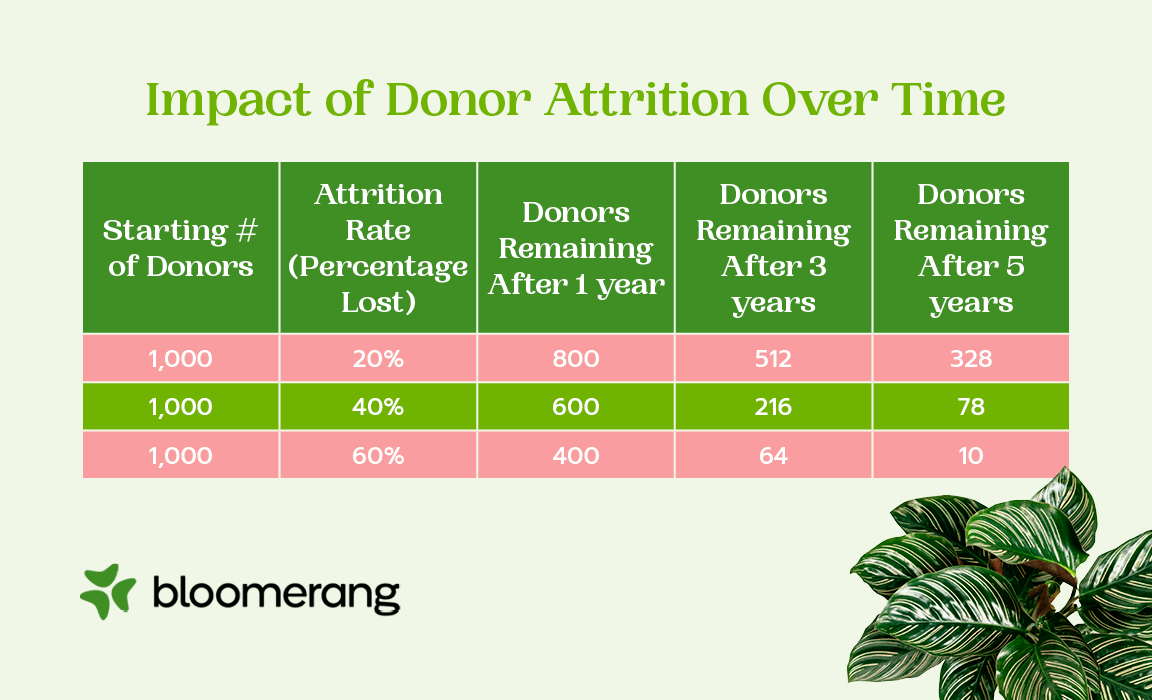A Guide to Donor Retention: Why It Matters for Nonprofits


Full Platform Overview Chat With Us



Full Platform Overview Chat With Us




If you’re a fundraiser or nonprofit development professional, you’ve likely heard the term “donor retention.” It’s one of the hottest topics of discussion in the nonprofit sector. But what exactly is donor retention? And why is it important?
Quite simply, donor retention is a measure of how many donors continue to donate to your organization. Nonprofits with a high donor retention rate have long-term supporters who come back year after year. Nonprofits with a low donor retention rate must continually acquire new donors or larger gifts to keep up.
The Association of Fundraising Professionals (AFP) and the Center on Nonprofits and Philanthropy at the Urban Institute worked together to establish and maintain the Fundraising Effectiveness Project. The Fundraising Effectiveness Project provides a platform for these organizations to conduct research that helps nonprofits improve their fundraising results faster.
Each quarter, FEP releases its findings, including changes in average donor retention rates over time. The most recent report for Q4 2024 explains that donor retention has decreased by 2.6% year over year, with nonprofits only retaining 19.4% of new donors year to date. This trend was most pronounced among micro ($1-$100) and small ($101-$500) donors ($501-$5,000), with year-over-year declines of 4.4% and 5.0%, respectively. However, all donor segments experienced decreases in donor retention.
This data illustrates the need for effective donor retention strategies, especially for smaller donors. While it’s important to actively retain major donors, they likely have a stronger bond and passion for your mission. Small donors require more pointed efforts to retain their support.
The FEP reports also explore donor frequency, specifically for new and repeat donors. New donor retention rates are even lower than the national average for all donors. However, if you can get a second donation (otherwise known as the golden donation), your retention rates increase dramatically because repeat donor retention is much higher.
According to FEP, new donors saw a retention rate decrease of 5.9% year over year, with only 19.4% of new donors retained year to date, whereas the repeat donor retention rate decreased by 3.0%, with a 69.2% year-to-date retention rate. This stark difference underscores the importance of soliciting that second gift for long-term retention.
The report also shows that donors who contribute more frequently are more likely to give again, with a one-time donor retention rate of 32.1% year to date, two-time donor retention rate of 53.0% year to date, three-to-six-time donor retention rate of 70.7% year to date, and seven-plus-time donor retention rate of 86.8%.
Again, soliciting a second gift can exponentially increase donor retention, as does soliciting subsequent gifts thereafter. Nonprofits that focus on receiving that golden donation naturally increase their average donor retention rate (about threefold!) because of this higher repeat retention rate.
“The continued decline in small donor participation, despite an increase in overall dollars, highlights the pressing need for renewed strategic focus.
Our Q4 FEP data emphasizes the growing reliance on fewer, larger gifts, a trend that underscores the urgency of revitalizing small donor engagement to sustain long-term sector health. While fundraisers should prioritize innovative approaches to attract new supporters and deepen loyalty among existing donors, we are committed to strengthening the fidelity and coverage of our FEP reporting, thereby broadening its capabilities and delivering deeper insights to equip organizations with the tools they need to face these headwinds.”
– Woodrow Rosenbaum,
Chief Data Officer of GivingTuesday
You can calculate your nonprofit’s donor retention rate by dividing the number of repeat donors this year by those who donated last year. For example, if you have 159 donors who gave again this year but had 300 who gave last year, your donor retention rate would be 53%.
It can become tiresome to calculate this equation by hand. We recommend investing in software that will help you automatically track your retention rate every year. This way, you’ll not only get today’s retention rate but also an overview of how well your retention rate is improving over time.
You can also use our free donor retention calculator below to visualize how your donor retention rate can impact your fundraising revenue. Simply plug in some basic information about your fundraising efforts and current donor retention rate to see what an increase in donor retention can do for your fundraising campaigns.
Additional fundraising revenue
Additional years of giving from your existing group of donors
Maybe this is the first time you’ve ever thought about your donor retention rate, or maybe you’ve had a pretty good idea of what your rate is but don’t think it’s anything to be worried about.
If you don’t consider donor retention, you’ll risk a higher attrition rate (the rate at which you lose donors). Take a look at how unchecked donor attrition can harm your organization over time:

You can see how quickly your pool of donors could evaporate, meaning increasingly less funding for your nonprofit. Just a small change in your donor retention rate (for instance, 10%) can cost your organization thousands of dollars!
Maybe you’re thinking, “Okay, so what if donors don’t give in consecutive years? They might come back someday.”
Think again.
According to FEP’s most recent data, the number of recaptured lapsed donors has decreased 8.6% year over year, meaning it’s increasingly difficult to gain back support from former contributors.
You cannot rely on this small recapture rate to compensate for low donor retention, which is why it’s crucial to retain donors from the beginning of their relationship with your organization.
If a new donor gives only once—as nearly 70% do—then you’re often left with a loss on your initial investment to gain that new donor. The true benefit of acquiring a donor can only come when you retain that donor over the long term.
While acquisition will always be important, nonprofits must focus on ways to keep new and existing donors coming back year after year.
Watch Bloomerang Co-Founder Jay Love discuss the donor retention issue with Bill Stanczykiewicz, Ed.D., on an episode of his podcast “First Day Podcast.”
Donor retention strategies are simple, but that’s not to say they’re easy. Often, it takes a large shift in a nonprofit’s mindset to focus on retaining donors rather than simply acquiring them.
As you consider the best donor retention strategies, consider how to engage donors with the resources you already have and the tools you’ll likely invest in. How can you easily offer additional ways to give or open up more engagement channels? For example, top donor engagement channels include recurring or monthly gifts to encourage long-term engagements, peer-to-peer campaigns to turn donors into fundraisers, phone calls to first-time donors, and direct mail to break through the digital clutter and stand out to donors.
Besides leveraging your tools, remember that donors want to know the impact of their dollars. They want to know that your organization appreciates them and values their opinions. Make sure you thank your donors not only after they give but also when your campaign is over. That’s the perfect time to inform your supporters of their impact on your mission. Recognize that your donors are the real change agents for your mission by sending them personalized communications and messages of gratitude.
Ensure your donor retention strategy includes the following components:
As your nonprofit focuses on improving its donor retention, it’s important that you have the best tools to track your donor retention rate and communications with supporters. What better place to do this than a donor database?
Bloomerang’s donor database is designed specifically with donor retention in mind. We don’t write a single line of code into our product without asking: Will this help retain more donors?
We’re committed to helping nonprofits achieve retention rates above the sector’s average, lower fundraising costs, and increase the lifetime value of donors in their communities.
Read on to see exactly how Bloomerang can help you retain more donors.
What better way to keep donors at the center of your focus than by seeing your current retention rate, updated daily, right on your dashboard? With this feature, you can easily click through to see which donors have been retained and which need additional attention.
Bloomerang users can audit their written content (such as letters and emails) through a “You” test and a Reading Level test to help ensure that donor communications hit the mark every time.
There’s no need to scour data file after data file or cluttered lists for a constituent’s history with your organization. Bloomerang’s timeline visually represents all interactions, including giving and volunteerism, while highlighting significant trends.
Bloomerang users can automatically send email surveys to donors that measure satisfaction, commitment, intimacy, and trust in your organization—all in one platform.
No matter how much a donor loves your mission and impact, they may not proactively inform you that they have a new address. Addresses are automatically updated in the Bloomerang database, and changes are displayed in the address note.
When a constituent donates for the first time, Bloomerang considers several factors, automatically prioritizes the top five first-time donors you should call directly, and displays this information on the Bloomerang dashboard.
Looking for more donor retention tips? Check out these additional Bloomerang resources:
Comments